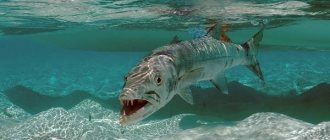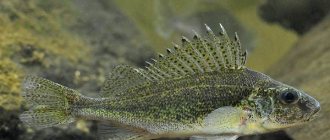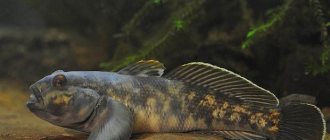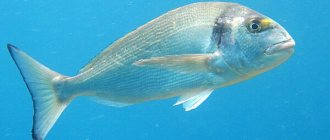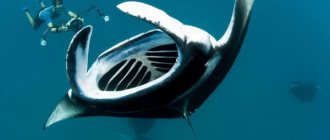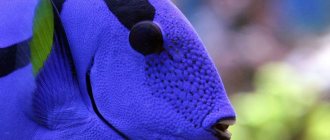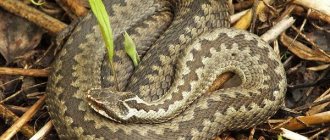Moray is a fish with a long history.
It has been known to mankind since ancient times. And not just as a delicacy. We call this genus the same way as the ancient Romans, who kept them at home (in villas in ponds and cages) - Muraena. Have you tried moray eel?
- No 59%, 138 votes
138 votes 59%138 votes - 59% of all votes
- Wouldn't risk it 26%, 62 votes
62 votes 26%
62 votes - 26% of all votes
- Yes 15%, 34 votes
34 votes 15%
34 votes - 15% of all votes
Total votes: 234
17.09.2019
- No 59%, 138 votes
138 votes 59%138 votes - 59% of all votes
- Wouldn't risk it 26%, 62 votes
62 votes 26%
62 votes - 26% of all votes
- Yes 15%, 34 votes
34 votes 15%
34 votes - 15% of all votes
Total votes: 234
17.09.2019
×
You or from your IP have already voted.
Description of moray eel fish with photo
An elongated body, a large head with an elongated snout, two pairs of nostrils and small eyes. They look frozen (in fact, they just see poorly - they distinguish movement, notice the difference between light and shadow, but orientation is carried out using the sense of smell and taste buds located on the entire surface of the body).
Wide mouth with conical fangs. Moray eel most often waits in ambush with its mouth constantly slightly open - to take in and release water (there are no gill slits). An interesting structure of the mouth: hidden in the depths of the regular one, devoid of a tongue, is a second one - a pharyngeal mini-version, which moves forward when capturing prey. The result is a grip with four jaws, strong, like that of a fighting dog, and these jaws are capable of tearing off a hefty piece of prey.
Fact. Despite their aggressiveness, these creatures are able to coexist in peace with their “helpers”: cleaner wrasses and orderly shrimp (they sit on their terrible faces and busily clean them of parasites and food debris). Sometimes they cooperate with groupers and hunt together among corals.
Where is it found?
Where does moray eel live? In all rocky and reef warm waters of the Atlantic and Pacific oceans. Lifestyle is characterized by three words:
- single;
- night;
- bottom
Have you tried moray eel?
- No 59%, 138 votes
138 votes 59%138 votes - 59% of all votes
- Wouldn't risk it 26%, 62 votes
62 votes 26%
62 votes - 26% of all votes
- Yes 15%, 34 votes
34 votes 15%
34 votes - 15% of all votes
Total votes: 234
17.09.2019
- No 59%, 138 votes
138 votes 59%138 votes - 59% of all votes
- Wouldn't risk it 26%, 62 votes
62 votes 26%
62 votes - 26% of all votes
- Yes 15%, 34 votes
34 votes 15%
34 votes - 15% of all votes
Total votes: 234
17.09.2019
×
You or from your IP have already voted.
Crevices in underwater rocks, clusters of corals, and mangrove forests are the favorite habitats of bottom hunters. There they sit in ambush, and woe to the living creatures that swim to where the moray eel lives! She eats:
- fish swallowed whole;
- cuttlefish and octopuses - they are torn to pieces. If a piece captured in the mouth stubbornly does not come off, the tail comes into play: it clings to the nearest support (usually a stone), the body curls up into a knot of strong elastic muscles, the tension rolls towards the head - and as a result, the pressure of the jaws increases many times;
- crabs, mollusks, crustaceans.
Fact. According to ichthyology, each individual has both male and female reproductive organs. This goes well with living alone. But “it takes two to love”: reproduction requires a male and a female! Which of them is which today - apparently, they decide in their own language...
Nutrition
The predatory moray eel uses an exclusively protein diet. Different species of moray eels are focused on a specific type of prey. Most prefer sea creatures that do not have a shell. These diets include:
- fish that are swallowed whole;
- octopuses and moray eels eat them piece by piece, tearing out pieces of flesh;
- cuttlefish, moray eels treat them as ruthlessly as octopuses.
A smaller number of moray eel species are durophagous, that is, animals that feed on organisms enclosed in a shell. Such moray eels attack crabs, shrimp, and shellfish.
Poisonous or not
For a long time it was believed that moray eels are poisonous and dangerous to humans not only because of their toothy mouth. Allegedly, her skin is covered with toxic mucus (there is no scientific evidence for this), and her teeth, like those of a snake, carry poison into the wounds (but there are no glands that produce it either). The bites are torn, very painful and take a long time to heal because saliva from the mouth gets into them, where food remains get stuck and, therefore, pathogenic bacteria multiply with might and main. There is a danger of poisoning from the meat of individuals that feed on toxic tropical animals.
Why is it dangerous?
Before a thorough study of the predator, it was believed that there were poisonous glands in the canals of its teeth. This assumption appeared after several deaths from the bite of a moray eel, but studies have proven the opposite, it is not a poisonous fish. Crooked teeth and bacteria growing between them are the only cause of infected lacerations, amputation or death.
INTERESTING: Moray quickly attacks, grabs the victim and begins to torment it like a pit bull. It is impossible to get rid of it without outside help, which explains the deep ruptures of the soft tissues. Therefore, it is better not to attempt to feed or pet the angry fish.
pixabay.com
Kinds
The genus includes 10 species of moray eels:
- appendiculata - found off the Chilean coast;
- argus - distributed off the coast of Peru, Galapagos Islands, Mexico;
- augusti - Atlantic near North Africa and southern Europe;
- clepsydra - Costa Rica, Colombia, Panama, Mexico;
- Muraena helena, or European, has been studied better than others by ichthyologists and is often encountered by divers. The main range is in the Mediterranean Sea, but can also be found in the eastern Atlantic;
- lentiginosa - eastern Pacific waters;
- melanotis - east and west Atlantic;
- pavonina, or spotted one, also lives in warm Atlantic waters;
- retifera - reticulated, when studying this particular species, a second jaw was discovered in the pharynx;
- robusta - eastern equatorial Atlantic.
These creatures are extremely diverse. The color, mainly camouflage, matches the color of the bottom, and can be marbled, spotted, striped, greenish-brown, light brown, yellowish, almost white. They also differ in size - large, medium, small.
The closest relatives from the same family are Gymnothoraxes. Also vary from small to hefty. The range of the black-spotted gymnatorax is Indo-Pacific; it feeds on small fish and crustaceans. The black dot does not grow longer than 80 cm. But its neighbor in its range, the Javan, reaches three meters in length and is capable of devouring a reef or tiger shark, and it is better for divers not to get in its way.
Due to devouring all living things that carelessly swim nearby, the Javanese gymnothorax accumulates a toxic substance in its tissues - ciugatoxin, which causes ciguatera disease (severe poisoning with vomiting, diarrhea, numbness of the lips and tongue, alternating fever and chills). But nothing threatens the number of these terrorists, there are no natural enemies, and people don’t catch them - who wants to get sick?
Freshwater
Freshwater moray, or Gymnothorax tile, is only called that - in fact it is a marine inhabitant. Small - about 60 cm. Biological characteristics and high adaptability allow it to live in fresh water bodies for a long time. The reservoir can be fresh up to 5 ppm. Feels great in salt water. Suitable habitats include both river estuaries (estuaries with expansion towards the sea) and coastal waters of Indonesia, the Philippines, and India.
Gold (yellow)
The golden one has other names: golden-tailed, yellow canary and even bastard eel. According to eyewitnesses, it looks like a floating banana, and the photos confirm this. Often the banana’s skin is also decorated with dark spots, and its mouth is white, which further enhances the resemblance. This is a small moray eel - size from 5 to 40 cm, in some cases it grows only up to 70. It lives throughout the western Atlantic - from Florida and Bermuda to southeastern Brazil. It is also found on the Cape Verde Islands, off the coast of Africa.
Black
British naturalist Mark Catesby, author of The Natural History of California, Florida and the Bahamas, described a certain species of moray eel - maculata nigra. He himself sketched and etched images of animals and plants on boards. There is a drawing and engraving from its original (dating back to 1750) - a black fish lies on the bottom, resting under the canopy of skinny coral and wrapping its tail around it.
Mediterranean
The Mediterranean moray (helena) is the most studied. The maximum body length is 1.5 m. It is not subject to mass fishing, but is sometimes caught individually - as a sport or for meat, on a hook or using traps.
Electric
And this creature is mythical. The myth arose due to its resemblance to an eel. Electric eels do exist - scientists recently analyzed data on them and identified three different species (previously it was thought there was one, Electrophorus electricus).
Green
Green Gymnothorax is a large, longest specimen measuring 2.5 m in length and weighing 29 kg. Found in the western Atlantic and northern Gulf of Mexico to Brazil. Occasionally settles near ports.
Danger to humans
It has long been believed that these toothy creatures do not attack unless provoked or disturbed in their natural habitat. But the events of recent years show: they can be dangerous for a person regardless of his behavior.
Moray eel bite
Many people have found out what it is without provoking bottom hunters in any way:
- 2015 - Irish scuba diver Jimmy Griffin was unexpectedly attacked in the face - bitten on the right cheek near the mouth. The grip was like that of a pit bull, the diver was shaken like a rag toy, he lost his breathing tube and almost died. The photograph immediately after the injury is scary to look at. 20 stitches. Fortunately, plastic surgeons stitched up the cheek perfectly. That same year, in Hawaii, a local surfer was bitten on the leg (not teasing anyone, he was surfing!);
- 2017 - a resident of the island of Crete was cleaning the day's catch near the water - apparently, the attack occurred due to the smell of blood and offal. The woman was bitten on the hand. She was urgently taken to the hospital in Elounda, where doctors treated deep wounds - otherwise the patient could have been left without fingers;
- 2018 - Polish master of underwater photography Bartosz Lukasik in the South African Bay of Sodwana filmed the communication of two individuals - only later did he realize that it was a mating ritual. The male chased the photographer for 15 meters - fortunately, he did not bite.
Important! When meeting these predators (especially at the mouth of a river, where they may be forced to find themselves), remember that they sometimes attack unmotivated. Stay away. Specialists in their behavior know how to communicate with them and feed them by hand - but for a beginner such an experience is traumatic.
Features of character and lifestyle
Photo: Moray eels
Moray eels are solitary, although they may appear to form schools. During the daytime, they hide in their gorges and among coral reefs, occasionally feeding. At night, moray eels lead a more active lifestyle, swimming out to hunt. Moray eel is a formidable predator. Swimming among the coral reefs at night, she eats everything she can reach. Moray eels rarely chase prey because of their slowness, but sometimes they chase their favorite delicacy - octopuses.
Most species of moray eels do not dive to depths of more than 50 meters, although there are deep-sea subspecies. Some moray eels are capable of a kind of cooperation with other fish. For example, the giant moray eel willingly cooperates with sea bass. The perch finds hidden mollusks and crayfish, the moray eel eats part of the prey, and gives some back to the perch in a dead form.
The older the moray eel, the less secretive it becomes. Old moray eels can swim out to hunt even during the daytime. They also become more aggressive as they age. Old moray eels are prone to cannibalism - they can eat young small individuals. There are frequent cases of moray eels attacking people. These fish show aggression if people are nearby, but do not purposefully attack them. In terms of the type of attack, they are similar to bulldogs: moray eels cling to the body and do not open their jaws until they tear off a piece. But after instantly absorbing a piece, the moray eel does not swim away, but clings on again.
As a rule, moray eels do not show aggression towards each other and are not territorial animals. They get along calmly in neighboring shelters without feeling competition.
Is it possible to eat
The ancient Romans would have sincerely laughed at the question of whether it was possible to eat moray eel - they considered it a delicacy that people deprived of wealth do not eat. It was bred in ponds and cages and used to prepare various dishes served at luxurious feasts. In the Roman book “On the Art of Cooking,” a unique collection of culinary recipes attributed to the famous gourmet Marcus Gavius Apicius, there are as many as six recipes for sauce for this fish - three for fried and three for boiled. Each contains between 9 and 12 ingredients!
Record sizes
Not only does it look gigantic, but it is also the most aggressive species. Found in tropical seas off East Africa, the giant moray eel measures up to 3 meters in length, weighing up to 30 kg. A chic leopard print color and a wide toothed mouth from which a second pair of teeth extends during an attack (some species also have this feature of the jaw structure), the ability to maneuver at high speed are distinctive features from other relatives. To the question whether this species can be eaten, there is a clear answer - due to the fact that it is at the top of the food chain in its habitat, ciguatoxin (a biological poison) has been found in moray eel meat more than once, which poses a danger to humans. It is one of the longest-livers of its species, with an average lifespan of 36 years.
Yandex pictures
Application
In the modern world, these peculiar fish are not cooked and eaten as actively as in antiquity; they are not objects of commercial fishing - they are more often kept for decorative purposes in large public aquariums or at home. In captivity, bottom hunters live for about 2 years (in their native salty environment they live up to 10). Keeping them is quite expensive - they are predators. And the first case of reproduction in captivity (2014, Schönbrunn Zoo in Austria) became a sensation in ichthyology.
Two famous Romans - lovers of these creatures - were workers, as they would say today, of intellectual labor: orators. Cicero's rival Quintus Hortensius regularly made money for all the fishermen of Naples, buying up all the catch to feed these gluttons in his marble ponds. And his colleague in the field, Lucius Crassus, had a pet fish and cried when it died.
The Romans, less intelligent, but more cruel, sometimes sought to feed offending slaves to their predatory favorites. Vedius Pollio, a supporter of Octavian Augustus, loved this “entertainment” and once intended to execute in this way a slave who broke a precious glass goblet. He begged Augustus for mercy, and the emperor simply broke all the other cups. I did the right thing.
